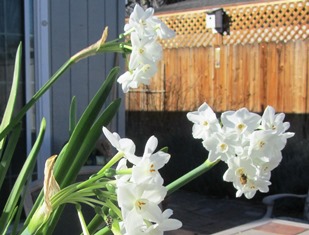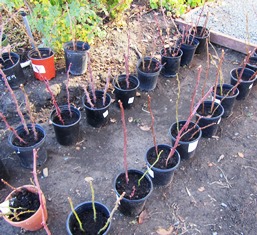Checklist for Bay Area Fruit Trees
In the Bay Area, January through February are optimal months for checking on your backyard fruit trees. After the leaves have dropped and the scaffolding is exposed, winter/early spring pruning is a lot easier.
The first months of the year are also the best times to feed, do orchard cleaning, and deal with overwintering pests.
Citrus trees, especially, benefit from a mid-winter check for magnesium or iron deficiency, indicated by yellowing of the leaves. You should also examine the trees for pests such as snails, ants, aphids and Leafminer. It’s also a good time to plan on how to protect your citrus against frost.
Handy Checklist
- Prune apples and pears for structure in late winter or early spring. Check for fire blight (look for a shepherd’s hook and the appearance of fire staining on limbs and the trunk). Remove wood 8-12 inches below infected areas and any obvious cankers. Feed when the trees leaf out.
- Check almonds, apricots, cherries, and plums for pests such as aphids, scale. Treat as necessary. Instead of pruning apricot and cherry trees in mid- to late winter, wait for late summer/early fall as winter rains can spread infections of Eutypa fungus that causes limbs to die back.
- Practice ongoing winter cleanup. Sanitation is of paramount importance in preventing pests infestations and fungal diseases. Regularly move fallen leaves, twigs, fruit, and other debris from the garden and orchard.
- Check citrus for infestation of Citrus Leafminer (look for brown lines and webbing on the leaves along with curling of the leaves. Treat the tree with Captain Jack’s organic fruit and vegetable spray. Application needs to be repeated every two weeks, especially when the tree is producing new growth, but no more than six times per season.
- Citrus leaves that are yellow or mottled with yellow when they should be bright green may have a magnesium or iron deficiency. Correct the chlorosis by applying iron. Prune citrus in mid-to-late March (here in the Bay Area).
___________________________________________________

Enjoy reading about farm topics? Check out my Henny Penny Farmette series of cozy mysteries. Chocked full of farm trivia and helpful advice for keeping chickens and bees and growing heirloom fruit and vegetables, all three novels are available online at Amazon and Barnes and Noble bookstores and in brick-and-mortar stores everywhere books are sold.
Preparing for an Early Spring
It’s winter. The nights are cold and the early mornings even colder. But here on the farmette, daytime temps are still unseasonably warm for this time of year in Northern California. That makes doing all the winter cleanup and spring preparation chores not only tolerable, but enjoyable.
We’ve pruned all the roses and taken cuttings for propagation of new bushes that we’ll plant around our property. We’ve divided the irises and planted the babies in new beds. Finally, we tackled pruning the fruit trees and imagine how shocked we were to find our Desert Gold peach trees with buds ready to open. The reason must be the warm weather.

The honeybees are searching for blossoms and finding none, they’re exploring the papaperwhite narcissus on my patio table
The honeybees are searching for flowers in bloom. They’ve flown to the citrus trees that I’ve covered against nighttime freezing temps and are wandering about on the blankets. The French perfume lavender still has some blooms but the bees seem also interested in the paperwhite narcissus blooms that I forced in water between Christmas and New Years Day.
We’ve moved the strawberries to a newly prepared bed in two planter boxes and are revitalizing the soil in the old boxes. Bare root season is around the corner and my husband and I are feeling the pressure to get the garden ready for a new growing season. The days are lengthening and we don’t want an early spring to catch us unprepared. Technically, winter has only just begun but the birds and bees and buds on the trees are suggesting it could be a short winter.
 Facebook
Facebook Goodreads
Goodreads LinkedIn
LinkedIn Meera Lester
Meera Lester Twitter
Twitter





